Entry Database : PDB / ID : 3mx0Title Crystal Structure of EphA2 ectodomain in complex with ephrin-A5 Ephrin type-A receptor 2 Ephrin-A5 Keywords / / / / Function / homology Function Domain/homology Component
/ / / / / / / / / / / / / / / / / / / / / / / / / / / / / / / / / / / / / / / / / / / / / / / / / / / / / / / / / / / / / / / / / / / / / / / / / / / / / / / / / / / / / / / / / / / / / / / / / / / / / / / / / / / / / / / / / / / / / / / / / / / / / / / / / / / / / / / / / / / / / / / / / / / / / / / / / / / / / / / / / / / / / Biological species Homo sapiens (human)Method / / / / Resolution : 3.506 Å Authors Himanen, J.P. / Yermekbayeva, L. / Janes, P.W. / Walker, J.R. / Xu, K. / Atapattu, L. / Rajashankar, K.R. / Mensinga, A. / Lackmann, M. / Nikolov, D.B. / Dhe-Paganon, S. Journal : Proc.Natl.Acad.Sci.USA / Year : 2010Title : Architecture of Eph receptor clusters.Authors : Himanen, J.P. / Yermekbayeva, L. / Janes, P.W. / Walker, J.R. / Xu, K. / Atapattu, L. / Rajashankar, K.R. / Mensinga, A. / Lackmann, M. / Nikolov, D.B. / Dhe-Paganon, S. History Deposition May 6, 2010 Deposition site / Processing site Revision 1.0 Jun 30, 2010 Provider / Type Revision 1.1 Jul 13, 2011 Group Revision 1.2 Nov 8, 2017 Group / Category Revision 2.0 Jul 29, 2020 Group Atomic model / Data collection ... Atomic model / Data collection / Derived calculations / Structure summary Category atom_site / chem_comp ... atom_site / chem_comp / entity / entity_name_com / pdbx_branch_scheme / pdbx_chem_comp_identifier / pdbx_entity_branch / pdbx_entity_branch_descriptor / pdbx_entity_branch_link / pdbx_entity_branch_list / pdbx_entity_nonpoly / pdbx_molecule_features / pdbx_nonpoly_scheme / pdbx_struct_assembly_gen / struct_asym / struct_conn / struct_site / struct_site_gen Item _atom_site.B_iso_or_equiv / _atom_site.Cartn_x ... _atom_site.B_iso_or_equiv / _atom_site.Cartn_x / _atom_site.Cartn_y / _atom_site.Cartn_z / _atom_site.auth_asym_id / _atom_site.auth_seq_id / _atom_site.label_asym_id / _atom_site.label_entity_id / _chem_comp.name / _chem_comp.type / _pdbx_entity_nonpoly.entity_id / _pdbx_entity_nonpoly.name / _pdbx_struct_assembly_gen.asym_id_list / _struct_conn.pdbx_dist_value / _struct_conn.pdbx_leaving_atom_flag / _struct_conn.pdbx_role / _struct_conn.ptnr1_auth_asym_id / _struct_conn.ptnr1_auth_comp_id / _struct_conn.ptnr1_auth_seq_id / _struct_conn.ptnr1_label_asym_id / _struct_conn.ptnr1_label_atom_id / _struct_conn.ptnr1_label_comp_id / _struct_conn.ptnr1_label_seq_id / _struct_conn.ptnr2_auth_asym_id / _struct_conn.ptnr2_auth_seq_id / _struct_conn.ptnr2_label_asym_id Description / Provider / Type
Show all Show less
 Open data
Open data Basic information
Basic information Components
Components Keywords
Keywords ectodomain / receptor-ligand complex / receptor-receptor interaction / TRANSFERASE RECEPTOR-SIGNALLING PROTEIN complex
ectodomain / receptor-ligand complex / receptor-receptor interaction / TRANSFERASE RECEPTOR-SIGNALLING PROTEIN complex Function and homology information
Function and homology information regulation of cell-cell adhesion / synaptic membrane adhesion / notochord cell development / notochord formation / lens fiber cell morphogenesis / blood vessel endothelial cell proliferation involved in sprouting angiogenesis / negative regulation of lymphangiogenesis ...neurotrophin TRKC receptor binding / neurotrophin TRKB receptor binding / negative regulation of substrate adhesion-dependent cell spreading /
regulation of cell-cell adhesion / synaptic membrane adhesion / notochord cell development / notochord formation / lens fiber cell morphogenesis / blood vessel endothelial cell proliferation involved in sprouting angiogenesis / negative regulation of lymphangiogenesis ...neurotrophin TRKC receptor binding / neurotrophin TRKB receptor binding / negative regulation of substrate adhesion-dependent cell spreading /  regulation of cell-cell adhesion / synaptic membrane adhesion / notochord cell development / notochord formation / lens fiber cell morphogenesis / blood vessel endothelial cell proliferation involved in sprouting angiogenesis / negative regulation of lymphangiogenesis / axial mesoderm formation / collateral sprouting / pericyte cell differentiation / cellular response to follicle-stimulating hormone stimulus / cAMP metabolic process / positive regulation of bicellular tight junction assembly / regulation of blood vessel endothelial cell migration / positive regulation of collateral sprouting / negative regulation of chemokine production / regulation of insulin secretion involved in cellular response to glucose stimulus /
regulation of cell-cell adhesion / synaptic membrane adhesion / notochord cell development / notochord formation / lens fiber cell morphogenesis / blood vessel endothelial cell proliferation involved in sprouting angiogenesis / negative regulation of lymphangiogenesis / axial mesoderm formation / collateral sprouting / pericyte cell differentiation / cellular response to follicle-stimulating hormone stimulus / cAMP metabolic process / positive regulation of bicellular tight junction assembly / regulation of blood vessel endothelial cell migration / positive regulation of collateral sprouting / negative regulation of chemokine production / regulation of insulin secretion involved in cellular response to glucose stimulus /  ephrin receptor activity / leading edge membrane /
ephrin receptor activity / leading edge membrane /  bone remodeling / post-anal tail morphogenesis / neurotrophin TRKA receptor binding /
bone remodeling / post-anal tail morphogenesis / neurotrophin TRKA receptor binding /  chemorepellent activity / response to growth factor / activation of GTPase activity / regulation of cell morphogenesis /
chemorepellent activity / response to growth factor / activation of GTPase activity / regulation of cell morphogenesis /  regulation of lamellipodium assembly / retinal ganglion cell axon guidance / positive regulation of synapse assembly /
regulation of lamellipodium assembly / retinal ganglion cell axon guidance / positive regulation of synapse assembly /  tight junction / branching involved in mammary gland duct morphogenesis / EPH-Ephrin signaling / neural tube development / RND1 GTPase cycle / RND2 GTPase cycle / RND3 GTPase cycle / mammary gland epithelial cell proliferation /
tight junction / branching involved in mammary gland duct morphogenesis / EPH-Ephrin signaling / neural tube development / RND1 GTPase cycle / RND2 GTPase cycle / RND3 GTPase cycle / mammary gland epithelial cell proliferation /  regulation of focal adhesion assembly / RHOV GTPase cycle /
regulation of focal adhesion assembly / RHOV GTPase cycle /  regulation of GTPase activity / EPHA-mediated growth cone collapse /
regulation of GTPase activity / EPHA-mediated growth cone collapse /  transmembrane receptor protein tyrosine kinase activator activity /
transmembrane receptor protein tyrosine kinase activator activity /  growth factor binding / regulation of cell adhesion mediated by integrin / lamellipodium membrane / RHOU GTPase cycle / RHOG GTPase cycle / EPH-ephrin mediated repulsion of cells /
growth factor binding / regulation of cell adhesion mediated by integrin / lamellipodium membrane / RHOU GTPase cycle / RHOG GTPase cycle / EPH-ephrin mediated repulsion of cells /  basement membrane / negative regulation of phosphatidylinositol 3-kinase/protein kinase B signal transduction / GABA-ergic synapse / ephrin receptor signaling pathway / RAC2 GTPase cycle / RAC3 GTPase cycle /
basement membrane / negative regulation of phosphatidylinositol 3-kinase/protein kinase B signal transduction / GABA-ergic synapse / ephrin receptor signaling pathway / RAC2 GTPase cycle / RAC3 GTPase cycle /  vasculogenesis /
vasculogenesis /  regulation of angiogenesis / regulation of microtubule cytoskeleton organization / cellular response to forskolin / keratinocyte differentiation / RAC1 GTPase cycle /
regulation of angiogenesis / regulation of microtubule cytoskeleton organization / cellular response to forskolin / keratinocyte differentiation / RAC1 GTPase cycle /  transmembrane receptor protein tyrosine kinase activity /
transmembrane receptor protein tyrosine kinase activity /  ephrin receptor binding / cell chemotaxis / negative regulation of angiogenesis / osteoclast differentiation / regulation of ERK1 and ERK2 cascade / phosphatidylinositol 3-kinase/protein kinase B signal transduction /
ephrin receptor binding / cell chemotaxis / negative regulation of angiogenesis / osteoclast differentiation / regulation of ERK1 and ERK2 cascade / phosphatidylinositol 3-kinase/protein kinase B signal transduction /  skeletal system development / molecular function activator activity /
skeletal system development / molecular function activator activity /  cell motility /
cell motility /  caveola /
caveola /  axon guidance / protein localization to plasma membrane / regulation of actin cytoskeleton organization / positive regulation of protein localization to plasma membrane /
axon guidance / protein localization to plasma membrane / regulation of actin cytoskeleton organization / positive regulation of protein localization to plasma membrane /  adherens junction /
adherens junction /  receptor protein-tyrosine kinase / neuron differentiation / ruffle membrane / osteoblast differentiation /
receptor protein-tyrosine kinase / neuron differentiation / ruffle membrane / osteoblast differentiation /  cell surface receptor protein tyrosine kinase signaling pathway / intrinsic apoptotic signaling pathway in response to DNA damage /
cell surface receptor protein tyrosine kinase signaling pathway / intrinsic apoptotic signaling pathway in response to DNA damage /  cell migration / positive regulation of peptidyl-tyrosine phosphorylation / virus receptor activity /
cell migration / positive regulation of peptidyl-tyrosine phosphorylation / virus receptor activity /  lamellipodium /
lamellipodium /  nervous system development /
nervous system development /  receptor complex /
receptor complex /  cell adhesion / positive regulation of cell migration / defense response to Gram-positive bacterium /
cell adhesion / positive regulation of cell migration / defense response to Gram-positive bacterium /  cadherin binding /
cadherin binding /  inflammatory response / positive regulation of protein phosphorylation / external side of plasma membrane /
inflammatory response / positive regulation of protein phosphorylation / external side of plasma membrane /  phosphorylation /
phosphorylation /  focal adhesion
focal adhesion
 Homo sapiens (human)
Homo sapiens (human) X-RAY DIFFRACTION /
X-RAY DIFFRACTION /  SYNCHROTRON /
SYNCHROTRON /  MOLECULAR REPLACEMENT /
MOLECULAR REPLACEMENT /  molecular replacement / Resolution: 3.506 Å
molecular replacement / Resolution: 3.506 Å  Authors
Authors Citation
Citation Journal: Proc.Natl.Acad.Sci.USA / Year: 2010
Journal: Proc.Natl.Acad.Sci.USA / Year: 2010 Structure visualization
Structure visualization Molmil
Molmil Jmol/JSmol
Jmol/JSmol Downloads & links
Downloads & links Download
Download 3mx0.cif.gz
3mx0.cif.gz PDBx/mmCIF format
PDBx/mmCIF format pdb3mx0.ent.gz
pdb3mx0.ent.gz PDB format
PDB format 3mx0.json.gz
3mx0.json.gz PDBx/mmJSON format
PDBx/mmJSON format Other downloads
Other downloads https://data.pdbj.org/pub/pdb/validation_reports/mx/3mx0
https://data.pdbj.org/pub/pdb/validation_reports/mx/3mx0 ftp://data.pdbj.org/pub/pdb/validation_reports/mx/3mx0
ftp://data.pdbj.org/pub/pdb/validation_reports/mx/3mx0 Links
Links Assembly
Assembly


 Components
Components
 Homo sapiens (human) / Gene: EPHA2, ECK / Plasmid: pDT101 / Cell line (production host): HEK-293 / Production host:
Homo sapiens (human) / Gene: EPHA2, ECK / Plasmid: pDT101 / Cell line (production host): HEK-293 / Production host: 
 Homo sapiens (human)
Homo sapiens (human) receptor protein-tyrosine kinase
receptor protein-tyrosine kinase Ephrin A5 / EPH-related receptor tyrosine kinase ligand 7 / LERK-7 / AL-1
Ephrin A5 / EPH-related receptor tyrosine kinase ligand 7 / LERK-7 / AL-1
 Homo sapiens (human) / Gene: EFNA5, EPLG7, LERK7 / Cell line (production host): HEK-293 / Production host:
Homo sapiens (human) / Gene: EFNA5, EPLG7, LERK7 / Cell line (production host): HEK-293 / Production host: 
 Homo sapiens (human) / References: UniProt: P52803
Homo sapiens (human) / References: UniProt: P52803 N-Acetylglucosamine
N-Acetylglucosamine X-RAY DIFFRACTION / Number of used crystals: 1
X-RAY DIFFRACTION / Number of used crystals: 1  Sample preparation
Sample preparation
 SYNCHROTRON / Site:
SYNCHROTRON / Site:  APS
APS  / Beamline: 24-ID-C / Wavelength: 0.98792 Å
/ Beamline: 24-ID-C / Wavelength: 0.98792 Å : 0.98792 Å / Relative weight: 1
: 0.98792 Å / Relative weight: 1 
 molecular replacement
molecular replacement Processing
Processing :
:  MOLECULAR REPLACEMENT / Resolution: 3.506→45.028 Å / Occupancy max: 1 / Occupancy min: 1 / SU ML: 0.38 / σ(F): 0.16 / Phase error: 33.16 / Stereochemistry target values: ML
MOLECULAR REPLACEMENT / Resolution: 3.506→45.028 Å / Occupancy max: 1 / Occupancy min: 1 / SU ML: 0.38 / σ(F): 0.16 / Phase error: 33.16 / Stereochemistry target values: ML Movie
Movie Controller
Controller





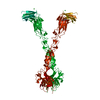
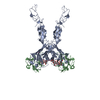


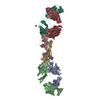
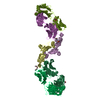
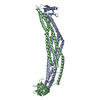
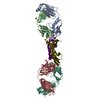


 PDBj
PDBj
















